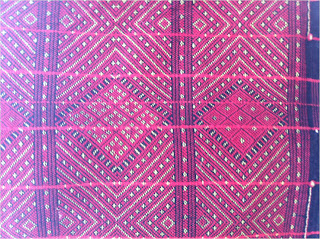This is a Peranakan or Straits Chinese runner that I bought from a local antique store in Amoy Street. It features playful dog-lions.
 |
The Peranakan Chinese (Peranakans) is an acculturated Chinese population residing in Malaysia, Singapore, Indonesia and Phuket. They are more commonly referred to as the Babas and Nonyas (Nyonyas) in Penang. They were also referred to as the Straits-born Chinese or Straits Chinese who were predominantly British citizens prior to Malaya’s independence, in differentiation from their contemporary new Chinese immigrants (sinkehs), in the late 19th to early 20th centuries.
Although there were Peranakan Chinese communities in Indonesia centuries earlier, the Peranakan material culture as we know of today was derived from the Peranakans who evolved in this region from the mid-18th century. There is no documented significant permanent Chinese population in Portuguese Malacca and a significant number of Chinese immigrants from South China only began to migrate to Malacca in the 1750’s coinciding with the relaxation of Chinese travel laws by the Emperor Qianlong in 1754. These early Chinese immigrants would likely to have taken regional native women, some of whom were bought as slaves, as their spouses. In Penang, early Chinese settlers from Kedah had followed Francis Light to Prince of Wales Island upon its establishment in 1786. Similarly in 1819 when Stamford Raffles ‘founded’ Singapore, the initial Chinese settlers had moved from Dutch Malacca which was in a state of economic decline.
As the local Chinese population became established and grew in numbers, their children would inter-marry giving rise to a recognisable Peranakan community. The Chinese immigrants who arrived later, up to the early 20th century, would marry the daughters of Peranakan families, frequently in a matrilocal arrangement, and became assimilated into the Peranakan fold. By the turn of the 20th century, there was increasing exposure to the education and language of the colonial rulers resulting in the Anglicisation of the Peranakan Chinese population in pre-independent Malaya.
Although there were Peranakan Chinese communities in Indonesia centuries earlier, the Peranakan material culture as we know of today was derived from the Peranakans who evolved in this region from the mid-18th century. There is no documented significant permanent Chinese population in Portuguese Malacca and a significant number of Chinese immigrants from South China only began to migrate to Malacca in the 1750’s coinciding with the relaxation of Chinese travel laws by the Emperor Qianlong in 1754. These early Chinese immigrants would likely to have taken regional native women, some of whom were bought as slaves, as their spouses. In Penang, early Chinese settlers from Kedah had followed Francis Light to Prince of Wales Island upon its establishment in 1786. Similarly in 1819 when Stamford Raffles ‘founded’ Singapore, the initial Chinese settlers had moved from Dutch Malacca which was in a state of economic decline.
As the local Chinese population became established and grew in numbers, their children would inter-marry giving rise to a recognisable Peranakan community. The Chinese immigrants who arrived later, up to the early 20th century, would marry the daughters of Peranakan families, frequently in a matrilocal arrangement, and became assimilated into the Peranakan fold. By the turn of the 20th century, there was increasing exposure to the education and language of the colonial rulers resulting in the Anglicisation of the Peranakan Chinese population in pre-independent Malaya.
This gradual evolution of the immigrant Chinese from the mid-18th to the early 20th century resulted in the development of an interesting and unique community which is inherently Chinese in their traditional religious beliefs and practices but incorporating indigenous social habits, culinary tastes and costumes, pari passu with the development of a hybridised Malay-Chinese (mainly Hokkien dialect) mode of communication which is known as Baba or Malay patois today. In Penang, the incorporation of Malay words into the Penang Hokkien dialect has also given rise to a unique spoken language by the babas and nonyas there. Eventually the increasing exposure to European influences led to the use of English as their lingua franca and the mass conversion of Malacca and Singapore Peranakans to Christianity.
http://www.phoenixandpeony.com/index.php












































